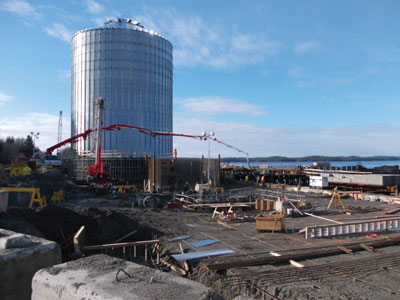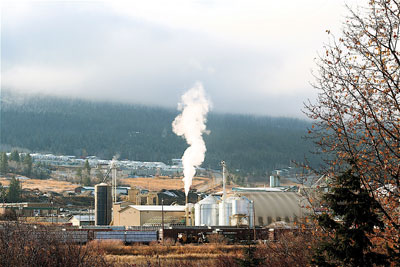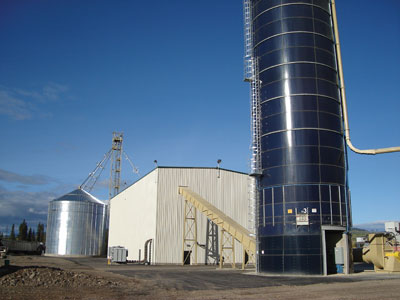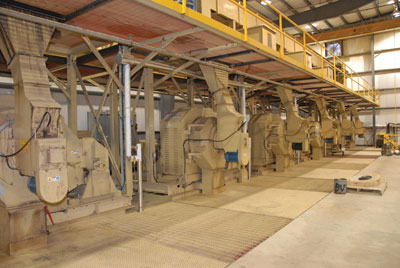
Doubling Down
March 27, 2013
By
John Tenpenny
Making sure no stone has been left unturned before moving on to the next
project is sound business practice and at Pinnacle Renewable Energy
Group it is a strategy for future expansion as wood pellet demand –
globally and domestically – continues to grow.
Making sure no stone has been left unturned before moving on to the next project is sound business practice and at Pinnacle Renewable Energy Group it is a strategy for future expansion as wood pellet demand – globally and domestically – continues to grow.
 |
|
| When completed, Pinnacle’s Westview Terminal in Prince Rupert, B.C., will include up to seven silos with a capacity of 85,000 tonnes and will be able to accommodate Panamax class vessels up to 75,000 deadweight tonnes (DWT).
|
For Leroy Reitsma, Pinnacle’s president and COO, the company’s growth has been based on its ability to handle a full spectrum of wood for production and being able to get its product to the export market as production capacity has grown from less than 100,000 tonnes in 2004 to more than 1.2 million tonnes today.
The company was founded by Rob and Jim Swaan in 1988 as Pinnacle Feed and Pellet, with its first plant in Quesnel, B.C. Expansion began in the early part of the 2000s, when, according to Reitsma, some the of European power companies started to view wood pellets as a potential displacement for coal. Beginning in 2004, Pinnacle constructed or acquired five more facilities.
“Our goal over the next three to five years is to more than double the size of the company from our current capacity of 1.2 million tonnes,” Reitsma tells Canadian Biomass, sitting in the lobby of a Prince George hotel earlier this year. “To achieve this there’s going to be some expansion of current facilities and some new builds that are associated with that.”
Terminal Project
While no specifics were forthcoming about those plans, Reitsma was happy to share the latest on Pinnacle’s current construction project – Westview Terminal – a $42-million wood pellet receiving, storage and shipping facility nearing completion in Prince Rupert.
“We’re still on track to put volume through there by the fall,” says Reitsma, noting the first silo went up in early January.
The project includes construction of private rail storage tracks, wood pellet receiving and unloading buildings, installation of a conveyor and ship loader system and up to seven silos with a capacity of 85,000 tonnes. The state-of-the-art facility will be able to unload up to ten rail cars per hour or approximately 1,000 tonnes and will be able to accommodate Panamax class vessels up to 75,000 deadweight tonnes (DWT) with a loading rate of up to 2,000 tonnes per hour.
With the development of Westview, the interface between both rail and port and port and ship will be greatly improved. “In the future when our train shows up there’s no getting into a queue; it’s our train gets unloaded now. And now when our ship comes in, it’s not waiting in the harbour for someone else’s to finish,” says Reitsma.
Having this logistical strength, he says, makes it possible for Pinnacle to focus on growth opportunities in the production chain to feed the port that would otherwise be uneconomical. “This is where we will grow.”
Westview was critical in allowing the company to make the economics of increased volumes work for them.
Torrefaction Time
For Reitsma, getting the logistics right also paves the way for Pinnacle’s investment in densification. Or put another way, now that the low-hanging fruit of logistics has been picked, the higher-hanging fruit of torrefaction can be considered.
 |
|
| Pinnacle’s Williams Lake plant was upgraded in 2008, going from two wood pelletizing machines to five and adding a drying system.
|
“Once you’ve optimized the logistics system in terms of both the configuration and velocity of assets, then you can start to look at fine-tuning it by further enhancing the energy value of the product,” he explains.
“We’re going to spend some fairly significant time and energy and money on energy densification.”
But this area doesn’t come without some major challenges, including technology and cost.
“In my mind there are some concerns around the safety aspects of getting the technology to a commercial scale, and making sure that you don’t have any issues with fire in the process,” says Reitsma. As well, making the process cost effective, so that “you don’t have people with doctoral degrees running the plants,” is another consideration.
The next step, according to Reitsma, is finding a customer who will actually pay for the extra costs of the product.
“What I’m finding is that when we talk to the major players in the marketplace, the response is simply along the lines of stating that any incremental benefit of energy densification needs to be offset by reductions in those costs incurred by the producer to deliver the product.
Generally, further energy densification is regarded as a neat trick, but not something that adds value to the bottom line of electricity producers, which can’t otherwise be achieved through capital investment at the power station.”
For example, he says, for one of Pinnacle’s customers that intends to consume eight million tonnes per year of wood pellets, the choice between an ongoing $10-per-tonne price increase versus a one-time investment to build the storage and the handling capability to handle the cheaper fuel is an easy decision.
However, if a power generator has other, more capital intensive, restrictions in the power station, they might, he says, be prepared to put the dollars on the table if pellet producers could help fill the need with something that has a little more energy density.
“Then you look at what is the capital tradeoff between trying to modify that capability of the boiler versus changing the fuel,” says Reitsma.
“Today there is no one in the market who is jumping forward to pay more money for the delivery of a torrefied product.”
Thus Pinnacle is going to proceed cautiously, but at the same time, keep in mind what the potential of torrefaction might be.
“We might find a totally different way, where all of a sudden the economics make sense.”
Fibre Source
Making wood pellets from different sources was and continues to be a big part of Pinnacle’s success and growth.
 |
|
| In partnership with Canfor Corporation and the Moricetown First Nation, Houston Pellet Inc. collects sawdust from the sawmill, which is dried and added to shavings in storage silos.
|
“There’s a tying together of multiple factors in any growth story and for us I think the biggest part of our story is that we were able to develop a process whereby we could handle a full spectrum of wood,” says Reitsma.
“We had to evolve first into being able to dry sawdust and make a good pellet out of that and then we learned how to handle bark and treetops and various other things.
“Then, as a result of the sawmill industry downturn in 2009, we had plant capacity in excess of the fibre supply. As a result, we went about trying to diversify our ability to process material, while still making sure that we produced a high-quality product.”
Alongside of a rebalancing of capacity in the sawmill sector reside the implications of the mountain pine beetle, which has presented both another challenge and another opportunity for Pinnacle to diversify and grow, says Reitsma.
“In any growth strategy, you need an expanding market and an ability to acquire both the raw materials and the logistical tools to meet the markets price demands. In British Columbia we’re quite fortunate to have the makings of the required combination.”
Certified Product
When it comes to product certification, Pinnacle has been and continues to be at the forefront in meeting the sustainability requirements of the European export market.
 |
|
| Pinnacle’s Meadowbrook plant’s production process features six Andritz Sprout pelletizers that process the wood fibre into quarter-inch pellets.
|
“Pinnacle’s recent contribution has been to take the standards and then find a way to make a wood pellet out of the full spectrum of wood that would comply with the standard. This builds on the work that was done in the early 2000s by the Swaan brothers, including John (who later took on a leadership role in the Wood Pellet Association of Canada), to pioneer the standards for bulk fuel supply from Western Canada to Europe,” explains Reitsma.
The company was also the beneficiary of operating within a well-developed forest industry in British Columbia where many of the certification standards were already part of the province’s forest practice codes. This is enabling Pinnacle to lead in sustainability requirements. “We are very fortunate to have well-developed and entrenched sustainability practices built into the forest industry in B.C.,” says Reitsma.
In fact, Reitsma is confident that the beneficial situation relative to other jurisdictions, where there isn’t the same level of forest stewardship planning and sustainability management, will allow the company to adapt its practices to be in alignment with pending European legislation objectives.
What Reitsma believes wood pellet producers will face in terms of new legislation from Europe will come in the form of creating a better chain of custody.
This will pose challenges, specifically at port facilities, where producers aggregate with other suppliers. “In the future, I can see the continuance of port access being contingent on the substantiation of sustainability requirements,” comments Reitsma.
In the early days of the industry, he says, there were different standards from different European power companies – each with its own version of what sustainability meant.
With a common standard, certain European ports may require that all pellets on a ship be certified under one sustainability requirement, which means all producers will have to meet the standard in order to acquire voyage on a particular ship.
“When we look outside of B.C., we can see jurisdictions where highly diverse land ownership will create chain of custody challenges for producers,” says Reitsma.
Asian Exports
While Europe continues to be the biggest export market for Pinnacle, Reitsma predicts considerable growth in Asia, particularly from Japan and South Korea, as their energy strategies focus more on the future versus the immediate term.
However, it’s a market that Reitsma says needs to mature, especially in the area of how transactions are done.
“Some [Asian buyers] are viewing the wood pellet market as an emerging commodity that has sufficient market liquidity to support a trading approach to the acquisition of product. However, because the production side of this business is in its early stages of coming into being, there’s not really an ability to get large volumes without a longer-term relationship between the producer and the consumer.”
The mindset in Asia is still a coal and oil-buying one and the shift to a non-commodity purchasing transaction hasn’t yet taken place.
“I think we’ll find a balance between the two schools of thought, but there certainly needs to be some adjustments in the process before it can really start to advance,” says Reitsma.
Gas Effects
Domestically, Reitsma sees a pair of opportunities for Pinnacle, both involving natural gas.
“There are opportunities for us in markets where people are not on the natural gas grid today where we can offset diesel consumption or some other higher-cost fuel.”
Reitsma also believes one outcome of proposed pipelines being developed to export natural gas that isn’t widely discussed, is that it’s going to have a long-term domestic price escalation effect.
“Once that export market is ready and available, I think you’ll see quite an increase in gas prices again,” he says. “And that’s going to spur on the ability to sell more [pellets] here in B.C. as an offset to escalating natural gas costs, much as we did four years ago, before the advent of shale gas technology.”
Regardless, the export market is still Pinnacle’s focus, even more so with the improvements the company has made on the logistics side.
As for the overall focus of the company, it has changed little over the years. Reitsma says it’s still about making a good product and getting it to where it needs to go.
“What makes this business viable, for us in particular, is the fact that we have a great forest resource, people that are excited about growing a successful business and a very good market. Once we understood how we could make a product out of our fibre resources, we’ve turned our attention over the past few years to optimizing the logistics of getting this product to market.”
| Pinnacle Production
Quesnel Williams Lake Armstrong Meadowbrook Burns Lake Houston Pellet Inc. |
Print this page